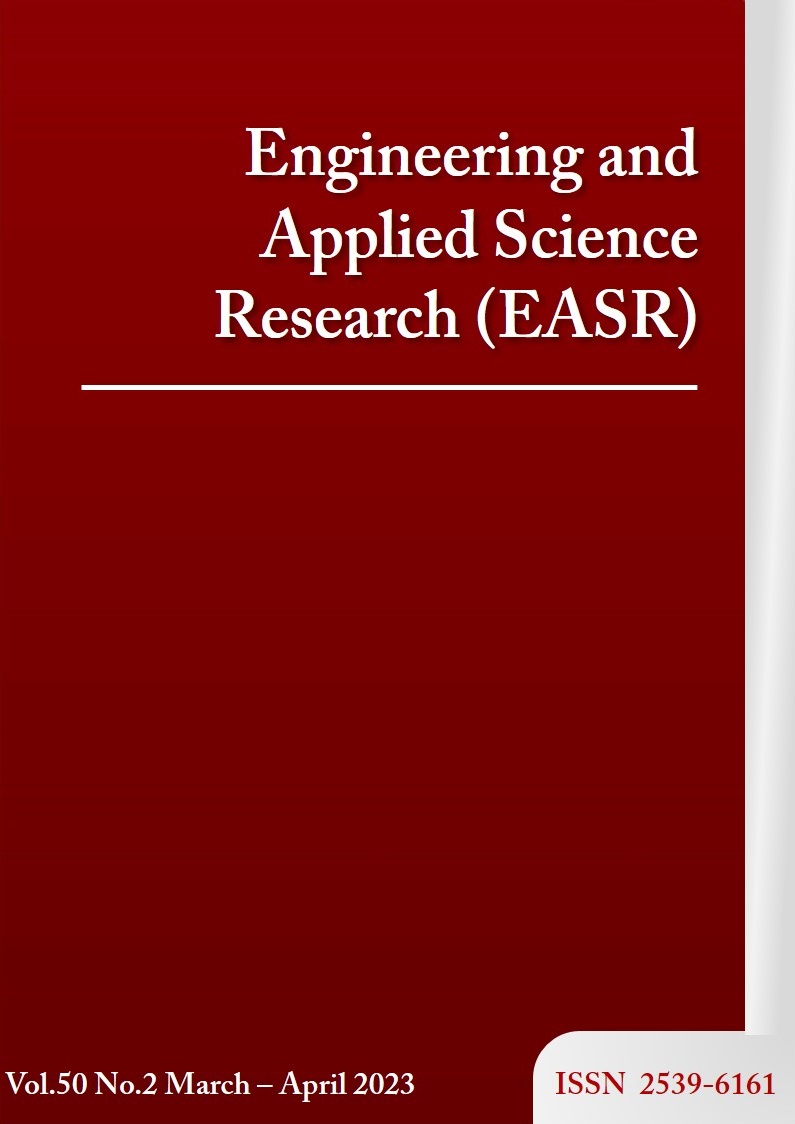Solving vehicle routing problem for waste disposal using modified differential evolution algorithm: A case study of waste disposal in Thailand
Main Article Content
Abstract
The aim of this study is to present a modified differential evolution (MDE) approach for solving the vehicle routing problem for waste disposal trucks by considering the routes that the vehicles take and their fuel consumption in order to obtain the lowest fuel consumption. The problem is complicated since there are several waste disposal sites, various waste types, various vehicle types, and various transport route speed specifications. In this study, three MDE techniques were employed: (1) the CR was set at 0.5 during the recombination phase and used the MDE-1 simulated annealing (SA) selection procedure, (2) the SA selection method was specified as MDE-2, and the self-adjusting CR value was adjusted from 0.9 to 0.1 in the recombination process, and (3) the recombination process was set up using a primitive selection process that is specified as MDE-3, and the CR value is set to automatically shift from 0.9 to 0.1. These three proposed models were tested with five small problems, five medium problems, and five large problems. The results showed that the proposed methods could solve the problem appropriately. In addition, three proposed models were tested with real data from a case study. The results showed that the MDE-1 method provided the best solution, followed by the MDE-2, MDE-3, and DE method, respectively.
Article Details

This work is licensed under a Creative Commons Attribution-NonCommercial-NoDerivatives 4.0 International License.
This work is licensed under a Creative Commons Attribution-NonCommercial-NoDerivatives 4.0 International License.
References
Japan Meteorological Agency. The state of greenhouse gases in the atmosphere based on global observations through [Internet]. Tokyo: World Meteorological Organization; 2021 [cited 2020 Nov 11]. Available from: https://reliefweb.int/country/wld.
Energy Policy and Planning Office (EPPO). Carbon dioxide (CO2) emissions from energy [Internet]. Bangkok: Ministry of Energy; 2020 [cited 2020 Nov 15]. Available from: https://www.eppo.go.th/index.php/en/en-energystatistics/co2-statistic.
Heinold A, Meisel F. Emission rates of intermodal rail/road and road-only transportation in Europe: a comprehensive simulation study. Transp Res D Transp Environ. 2018;65:421-37.
Khamjan W, Khamjan S, Pathumnakul S. Determination of the locations and capacities of sugar cane loading stations in Thailand. Comput Ind Eng. 2013;66(4):663-74.
Willemse EJ, Joubert JW. Efficient local search strategies for the mixed capacitated Arc routing problems under time restrictions with intermediate facilities. Comput Oper Res. 2019;105:203-25.
Ayeleru OO, Okonta FN, Ntuli F. Municipal solid waste generation and characterization in the city of Johannesburg: a pathway for the implementation of zero waste. Waste Manage. 2018;79:87-97.
Yadava V, Bhurjee AK, Karmakar S, Dikshit AK. A facility location model for municipal solid waste management system under uncertain environment. Sci Total Environ. 2017;603-604:760-71.
Yadav V, Karmakar S, Dikshit AK, Bhurjee AK. Interval-valued facility location model: an appraisal of municipal solid waste management system. J Clean Prod. 2018;171:250-63.
Eiselta HA, Marianov V. Location modeling for municipal solid waste facilities. Comput Oper Res. 2015;62:305-15.
Das S, Bhattacharyya B. Optimization of municipal solid waste collection and transportation routes. Waste Manage. 2015;43:9-18.
Pollution Control Department. Report on the situation of municipal solid waste disposal sites in Thailand for the year 2021 [Internet]. Thailand: Ministry of Natural Resources and Environment; 2021 [cited 2022 Mar 1]. Available from: https://www.pcd.go.th/publication/26832.
Pollution Control Department. National waste management action plan (2022-2027) [Internet]. Thailand: Ministry of Natural Resources and Environment; 2021. [cited 2022 Mar 1]. Available from: https://www.pcd.go.th/wp-content/uploads/2021/ 10/pcdnew-2021-10-16_05-41-25_882141.pdf.
Asefi H, Lim S. A novel multi-dimensional modeling approach to integrated municipal solid waste management. J Clean Prod. 2017;166:1131-43.
Boonmee C, Arimura M, Asada T. Location and allocation optimization for integrated decisions on post-disaster waste supply chain management: On-site and off-site separation for recyclable materials. Int J Disaster Risk Reduct. 2018;31:902-17.
Asefi H, Lim S, Maghrebi M, Shahparvari S. Mathematical modelling and heuristic approaches to the location-routing problem of a cost-effective integrated solid waste management. Ann Oper Res. 2019;273:75-110.
Goudos SK, Plets D, Liu N, Martens L, Joseph W. A multi-objective approach to indoor wireless heterogeneous network planning bases on biogeography-bases optimization. Comput Netw. 2015;91:564-76.
Supattananon N, Akararungruangkul R. Modified differential evolution algorithm for a transportation software application. J Open Innov Technol Mark Complex. 2019;5(4):84.
Sethanana K, Pitakaso R Differential evolution algorithms for scheduling raw milk transportation. Comput Electron Agric. 2016;121:245-59.
Moonsri K, Sethanan K, Worasan K. A novel enhanced differential evolution algorithm for outbound logistics of the poultry industry in Thailand. J Open Innov Technol Mark Complex. 2022;8(1):15.
Zou D, Liu H, Gao L, Li S. A novel modified differential evolution algorithm for constrained optimization problems. Comput. Math. Appl. 2011;61(6):1608-23.
Moonsri K, Sethanan K, Worasan K, Nitisiri K. A hybrid and self-adaptive differential evolution algorithm for the multi-depot vehicle routing problem in egg distribution. Appl Sci. 2022;12(1):35.
Gonwirat S, Surinta O. Optimal weighted parameters of ensemble convolutional neural networks based on a differential evolution algorithm for enhancing pornographic image classification: Eng Appl Sci Res. 2021;48(5):560-9.



